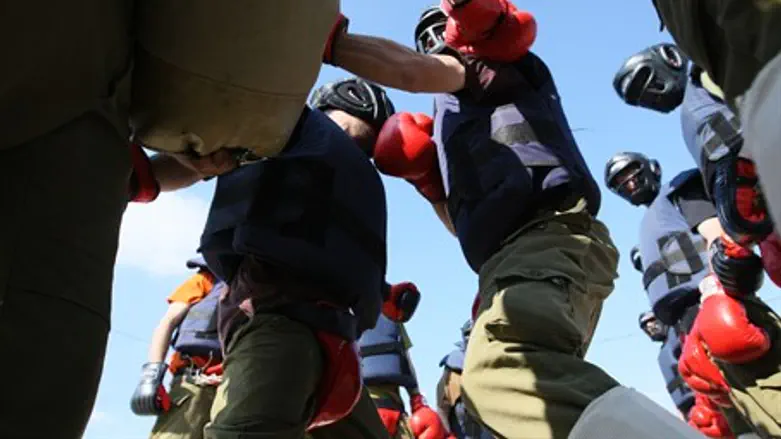
Krav Maga, the close-combat method conceived in secrecy by the Israeli army, has kicked its way firmly into civilian life and with Hollywood's help, has become the ultimate form of self-defense.
"The idea is to be able to quickly hit the aggressor's vulnerable spots and to defend yourself with whatever is available - a beer bottle or a stick," explains Elad Nimni, who teaches Krav Maga in the IDF.
"Or, if you're doing military Krav Maga, you can use a gun instead of your body, because your body can get damaged and that hurts," he tells AFP, wearing military fatigues, his muscles rippling under a tight black t-shirt.
Although Krav Maga - which is Hebrew for 'contact combat' - borrows techniques from boxing, wrestling and jiu jistu, it differs from all other combat sports in one way: there are no rules.
Krav Maga is all about saving your own skin, and anything goes.
But interest in the streetwise style of fighting has stretched far beyond Israel, notching up diehard fans from Hampstead to Hollywood, among them A-listers like Angelina Jolie and husband Brad Pitt, whose daily workouts reportedly caused him to bulk up his muscles and "dramatically" lose weight.
It has even been adapted by one young Israeli from Canada who teaches women how to use their stiletto heels to fight off an aggressor in a method she developed after being sexually assaulted.
And in France, there has been a surge of interest in Krav Maga since the November attacks on Paris, with regional groups reportedly clocking up record numbers of new students.
In the gym on a military base in northern Israel where Nimni works, the pungent odor of sweat mixes with loud techno music, as infantry soldiers carrying all their gear simulate realistic hand-to-hand combat situations.
From the sidelines, instructors scream at them, pushing them harder in order to both raise their heart rate and increase their stress levels.
The idea, says Nimni, is for soldiers to learn to defend themselves when they don't have the time, nor the opportunity and in situations when they can't use their weapons.
In recent months, instructors have introduced long plastic knives into the training following a surge in Palestinian knife attacks across sovereign Israeli territory as well as Judea and Samaria.
"It's our treasure"
"I see the difference in a soldier before and after his first Krav Maga training," says Nimni.
"It builds his confidence, he clutches his weapon less, he realizes he's less dependent on it."
The training sessions - around 20 over a period of six months for combat soldiers, but fewer for those in a non-fighting role - are a mandatory part of military service, which in Israel is compulsory.
The system was developed by a Hungarian Jew called Imi Lichtenfeld. With Nazism and Fascism on the rise in 1930s Europe, he gathered around him a group of young Jews whom he wanted to train in self-defense.
Fleeing Europe in the early 1940s, he joined the Israeli army in 1948 where he tried to develop a method of self-defense that was simple, effective and quick to learn in order to meet the military's needs.
Krav Maga immediately became part of the army's doctrine, and has evolved over the years in line with the needs and feedback of soldiers in the field.
In the 1980s, Lichtenfeld instructed his protege Eli Avikzar to take Krav Maga onto the international stage.
Several foreign militaries have since adopted the method, recruiting former Israeli army instructors to teach their troops.
"Within a few years, Krav Maga has become extremely widespread, but it is our treasure, we are proud of it and we protect it," says Nimni who hasn't yet decided whether he would be willing to 'export' his skills abroad.
"Like an addiction"
Spectacular in its violence, Krav Maga has become prominent in video games and action movies, such as "The Bourne Ultimatum" (2007), "Taken" (2008) and the "X-Men" series.
"From a Hollywood point of view, it looks very good," says Chris Couch, a US marine who became a black belt and Krav Maga instructor in 2014.
"They're trying to be more realistic in their fighting and Krav (Maga) is very fast, very dirty, very to the point."
Couch says he is seeing more and more fathers, but also women and children, signing up to his studio in Los Angeles.
It is not out of a desire to fight but a need for self-defense, he explains.
"We always tell people that we need to do everything that is necessary, but only what is necessary," he says.
"It's not our job to detain a bad guy or anything like that. Our primary purpose is to get away and get home safe."
Alan Garcia, a bouncer at a Los Angeles night club, has been training in the method for four years. The aim is to "neutralize" troublesome punters "before they get to the fight" but he says he also finds real pleasure in the "adrenaline rush" during training.
"It's like an addiction. I go to the gym at least twice a week," says Alex Jackson, a 38-year-old teacher.
"It may have a bad reputation, but this is something that I only do in the gym, although it's true that now I feel more confident and safe."
AFP contributed to this report.